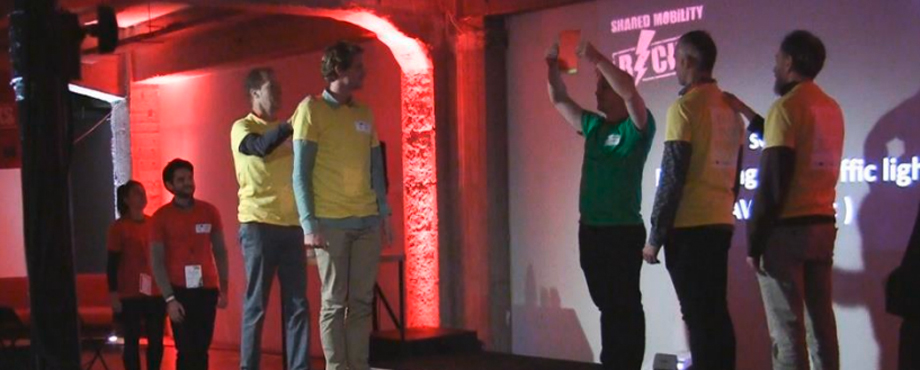Imagine a busy intersection at the heart of a big city. Lot’s off pedestrians, cyclists, car drivers, trams and other mobility users pass this intersection every day. Most of the times this interaction of actors with different speed, length and weight goes without incidents, but it’s never without a risk. Accidents do happen and unfortunately sometimes have a fatal outcome. In addition, traffic does not always run smoothly. Traffic lights cause increasing waiting times and the inefficient departure of cars after lights hitting green makes the congestions even longer.
Imagine we could find a way to avoid collisions between different mobility users and in the same time fight traffic delays? Imagine we could find a way to avoid people making stupid or even fatal decisions while driving a car or another motorized vehicle? How should this solution look like and what would happen the moment we adopt this solution in real life?
Whit this premises the ART-Forum workshop at Shared Mobility Rocks1 kicked off. Michael Glotz-Richter and Suzanne Hoadley moderated the interactive session on the potential future impact of automated vehicles on our road transport system . Automated road transport has the ability to deliver a solution for both problems described above. However, the emerging technology also brings up some new questions. During the workshop we fired up the discussion on both advantages and disadvantages of automated road transport, yet not in a traditional way.
Experiment
In order to really experience the potential consequences of automated vehicles first hand, participants of the workshop were divided into three groups, wearing three different types of t-shirts.
The green ones represent active road users, being pedestrians and cyclists.
- They can communicate to each other, are afraid of conventional cars,
- are afraid of conventional cars,
- but are smart and know that autonomous cars will stop if they suddenly cross the street
The second group, wearing red t-shirts, represents conventional cars.
- For them it is hard to communicate with other road users,
- they sometimes drive to fast,
- and need space to open their doors.
The last ones, dressed in yellow, were chosen to be autonomous cars (SAE level 5)
- They can communicate with other autonomous cars,
- are very cautious and brake for every obstacle or road user,
- and can platoon3 with other autonomous cars.
During three experiments attendees were asked to behave according to the rules applied to their group.
- In the first experiment only people behaving like an autonomous vehicle could come on stage and cross the imaginary intersection. This went very smoothly. Trough platooning, the traffic flow increased significantly, which also had a positive impact on the road capacity and safety.
- In a second phase, conventional cars were added to traffic. Immediately it became clear mixing up autonomous and conventional cars brings new challenges. Cars with human drivers behave more assertive, knowing that the autonomous cars will brake when they approach, and their actions are less predictable. This causes a lower traffic flow and lower road capacity.
- The third experiment, combining autonomous vehicles, conventional cars and active road users, very quickly resulted in a chaotic situation. Pedestrians and cyclists have a lot of power over autonomous cars and use this advantage. Together with the presence of impulsive conventional car drivers, this causes autonomous cars to stand still most of the time
Pros and Cons
Undoubtedly, autonomous driving can bring huge advantages to the current mobility system. It has the ability to increase road safety and traffic flows and to implement more efficient forms of parking management, since cars can be parked very close to each other. Furthermore, a large share of the current car fleet could be removed from the streets. According to the International Transport Forum4 with the help of ride-sharing Taxibots up to 90% of all road vehicles can be replaced, “while still delivering nearly the same level of mobility as before”. It’s important to note the ITF modelled this autonomous Taxibots in a mobility ecosystem backed by high-capacity public transport, like metro and light rail. Qualitative public transport should therefore be seen as a conditio sine qua non for large replacements of the current car fleet with the introduction of autonomous cars.
However the participants of the workshop were also confronted with a large potential downside of the technology. We can expect a huge increase of traffic through the implementation of autonomous vehicles. Michael Glotz-Richter pointed out four reasons why traffic volume will increase, even with fewer cars.
- Autonomous cars will be the most convenient way of travelling door-to-door. This will lead to a negative modal shift from public transport and active ways of transport to the use of cars.
- New user groups without driving licence will have access to individual cars without a driver. From a social point of view, this means progress for the new user groups, but with a cost of extra kilometres driven by cars.
- Travelling by car will no longer be perceived as “lost time” what will affect the perception of travelling.
- Autonomous driving can have a negative impact on urban development too. Given the three reasons mentioned above, people have less incentives to live closer to (their job in) the city, leading to more urban sprawl and more trips by car.
Not yet understood how the workshop worked? Watch the video!
More informations about the event Shared Mobility Rocks
http://www.shared-mobility.rocks/



